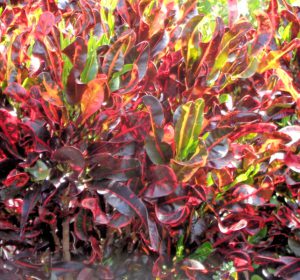
No other ornamental foliage plant quite meets the definition of “tropical” like a croton does. Crotons bring bright colors, interesting leaf shapes and variations that catch the eye and enhance a . You see crotons for sale at every garden center as they tend to be a “must have” and sell themselves with stunning colors. Hardy in zones 9b through 11, crotons can grow here, but may need protection during cold snaps. Useful both inside and outside, crotons are for everybody.
Originally from India, Malaysia and several South Pacific Islands, crotons were selected for leaf colors ranging from red to orange to yellow to green with all types of variegation and color splashes. And if the color was not enough, the shapes and sizes of the leaves are spectacular from thin and narrow and almost grass blade-like to wide and broad. Various twists and turns add another dimension as croton leaves are often cork-screwed in shape or have other wild contorted attributes. Crotons are used outdoors in mass plantings, in containers, and as foundation plantings. Planted outdoors in the landscape, they can grow up to six feet tall and six-feet wide. Planting crotons three feet apart on center is the suggested distance between plants. If growing in containers, use a four-to-seven-gallon pot to develop a nice plant. Those grown in full sun will have the best color with some exceptions – too much light will actually cause red and orange leaf colors to fade. Croton leaves begin green and then color-up as they mature if they get enough light. For indoor use, crotons have less light, but can still maintain their color for months.
Another use of crotons is the floral quality of these plants. With such a variety in color and shape, cut croton parts make excellent subjects for vases and can be used in many flower arrangements. Single leaves can be used by simply twisting them off from the stem. Small stems should be removed with pruners.
If you want to make more crotons from your original, propagation is a fairly easy chore. Tip cuttings of three to six inches each with three to five leaves stuck in a sterile potting medium will root in about four weeks.
To pick a favorite croton variety is a difficult task as all have some type of desirable feature. For instance, ‘Gold Star’ has a thin green leaf speckled with golden spots. ‘Yellow Icing’ has a broader yellow-green leaf with green veins and green margins. Another common cultivar, ‘Petra’ combines a creamy reddish leave with blotches of dark green. “Spirale’ is noted for red and green spirally twisted leaves. I particularly like the appropriately named ‘Sloppy Painter’. There are so many more to collect if you want to become a true croton aficionado.
There should be at least one croton in every local landscape. I have one, and in spite of some recent freeze damage, it always comes back dependability year after year! For more information on all types of colorful shrubs suitable for our area, or to ask a question, please visit https://www.facebook.com/CharlotteMGLifeline/ . You can also call the Master Gardener Volunteer Helpdesk on Mondays, Wednesdays, and Fridays from 1 to 4 pm at 764-4340 for gardening help and insight into their role as an Extension volunteer. Ralph E. Mitchell is the Director/Horticulture Agent for the UF/IFAS Charlotte County Extension Service. He can be reached at 941-764-4344 or ralph.mitchell@charlottecountyfl.gov
Resources:
Stamps, R. H. & Osborne, L. S. (2019) Croton Production and Use. The University of Florida Extension Service, IFAS.
Gilman, E. F. (1999) Codiaeum variegatum. The University of Florida Extension Service, IFAS.
Landre, C. (2021) Crotons – Codiaeum variegatum. south-florida-plant-guide.
UF/IFAS Gardening Solutions – Crotons. The University of Florida Extension Service, IFAS.
 1
1
